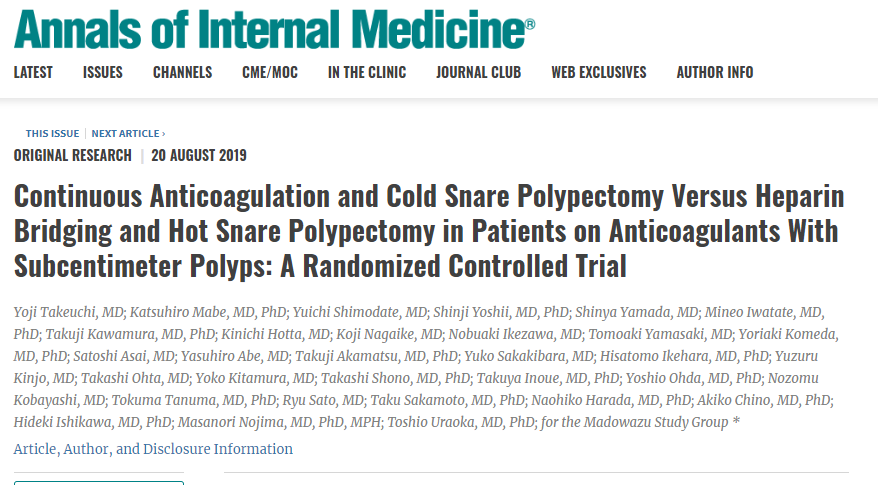Cold snare polypectomy for small polyps in anticoagulated patients (August 2019)
- Cold snare polypectomy는 항응고제를 계속 복용하였고 hot snare polypectomy는 briged with heparin을 한 경우입니다. -
Cold snare polypectomy (CSP) is used to remove small colon polyps; however, safety data for this technique in anticoagulated patients are limited. In a trial including 184 anticoagulated patients with colon polyps <1 cm, the rate of postpolypectomy bleeding trended lower in patients who had CSP while on uninterrupted anticoagulation compared with patients who had hot snare polypectomy while being bridged with heparin (5 versus 12 percent). We use CSP to remove polyps <1 cm because this technique is safe and effective.
Polyps <1 cm — We use cold snare polypectomy for polyps ranging in size from 4 to 9 mm because this approach is effective and reduces the risk of delayed PPB, while diminutive polyps (1 to 3 mm) can be removed with either a cold snare or cold biopsy forceps. Cold polypectomy is a technique that does not require electric current, while hot snare polypectomy uses an electrocautery snare.
In a trial including 538 patients with a total of 796 polyps ranging from 4 to 9 mm in size, complete resection rates were similar for cold snare compared with hot snare technique (98 versus 97 percent); however, delayed PPB was observed in the hot snare polypectomy group only (2 of 402 polyps, 0.5 percent).
In addition, data suggest that cold snare technique is associated with lower rates of PPB for anticoagulated patients. In a trial of 70 patients on warfarin with a total of 159 polyps ≤1 cm, rates of delayed bleeding were lower in patients who underwent polypectomy with cold snare compared with snare electrocautery (0 versus 14 percent). In a trial of 184 anticoagulated patients with polyps <1 cm, rates of PPB were lower (but not statistically significant) in patients who had cold snare polypectomy while on uninterrupted anticoagulation (warfarin or direct oral anticoagulant) compared with patients who had hot snare polypectomy while being bridged with heparin (5 versus 12 percent, risk difference 7 percent [95% CI -1 to 16 percent]).
Cold polypectomy technique is advantageous for removing polyps <1 cm because such polyps have small blood vessels that do not require electrocautery, which can result in an expanding zone of necrosis, leading to delayed PPB.
텍스트 추가

대표사진 삭제
사진 설명을 입력하세요.
텍스트 추가
Abstract
Background:
Management of anticoagulants for patients undergoing polypectomy is still controversial. Cold snare polypectomy (CSP) is reported to cause less bleeding than hot snare polypectomy (HSP).
Objective:
To compare outcomes between continuous administration of anticoagulants (CA) with CSP (CA+CSP) and periprocedural heparin bridging (HB) with HSP (HB+HSP) for subcentimeter colorectal polyps.
Design:
Multicenter, parallel, noninferiority randomized controlled trial. (University Hospital Medical Information Network Clinical Trials Registry: UMIN000019355)
Setting:
30 Japanese institutions.
Patients:
Patients receiving anticoagulant therapy (warfarin or direct oral anticoagulants) who had at least 1 nonpedunculated subcentimeter colorectal polyp.
Intervention:
Patients were randomly assigned to undergo HB+HSP or CA+CSP and followed up 28 days after polypectomy.
Measurements:
The primary end point was incidence of polypectomy-related major bleeding (based on the incidence of poorly controlled intraprocedural bleeding or postpolypectomy bleeding requiring endoscopic hemostasis). The prespecified inferiority margin was −5% (CA+CSP vs. HB+HSP).
Results:
A total of 184 patients were enrolled: 90 in the HB+HSP group, 92 in the CA+CSP group, and 2 who declined to participate after enrollment. The incidence of polypectomy-related major bleeding in the HB+HSP and CA+CSP groups was 12.0% (95% CI, 5.0% to 19.1%) and 4.7% (CI, 0.2% to 9.2%), respectively. The intergroup difference for the primary end point was +7.3% (CI, −1.0% to 15.7%), with a 0.4% lower limit of 2-sided 90% CI, demonstrating the noninferiority of CA+CSP. The mean procedure time for each polyp and the hospitalization period were longer in the HB+HSP than in the CA+CSP group.
Limitation:
An open-label trial assessing 2 factors (anticoagulation approach and polypectomy procedure type) simultaneously.
Conclusion:
Patients having CA+CSP for subcentimeter colorectal polyps who were receiving oral anticoagulants did not have an increased incidence of polypectomy-related major bleeding, and procedure time and hospitalization were shorter than in those having HB+HSP.
Primary Funding Source:
Japanese Gastroenterological Association.
'소화기내과(위장관) > 위장관출혈' 카테고리의 다른 글
| 성인 남자/폐경후 여성에서 철결핍성 빈혈이 있을 때 위장관 검사를 시행해야 합니다. (0) | 2020.01.01 |
|---|---|
| 분변잠혈검사/혈변과 대장내시경 (0) | 2019.11.30 |
| 대장내시경 용종 절제술 후 출혈 예방을 위한 clip closure가 도움이 되는 경우 (0) | 2019.10.13 |
| 내시경 소견에 근거한 상부위장관 출혈 환자를 위한 제안된 알고리즘(빈도, 재출혈 위험, 내시경적 지혈 이후 재출혈 위험) (0) | 2019.08.30 |
| Common causes of lower gastrointestinal bleeding (0) | 2019.08.29 |



